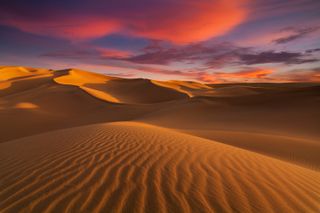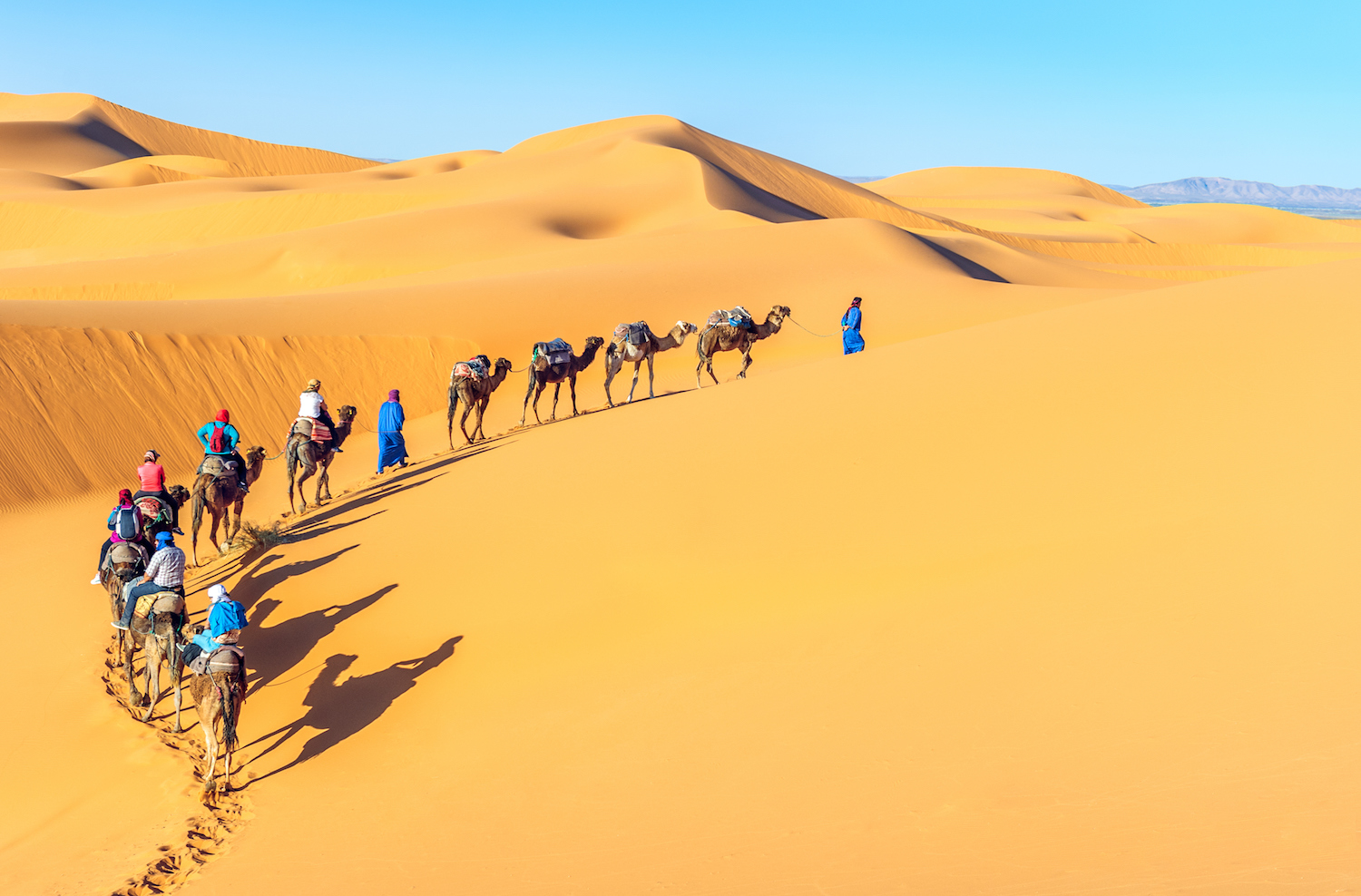Where Do People Live in the Sahara Where Do People Work in the Sahara
The Sahara: Earth's Largest Hot Desert

The Sahara is the largest hot desert in the world, and the third largest desert behind Antarctica and the Arctic, which are both cold deserts. The Sahara is one of the harshest environments on Earth, covering 3.6 million square miles (9.4 million square kilometers), nearly a third of the African continent, about the size of the United States (including Alaska and Hawaii). The name of the desert comes from the Arabic word ṣaḥrāʾ, which means "desert."
Geography
The Sahara is bordered by the Atlantic Ocean on the west, the Red Sea on the east, the Mediterranean Sea on the north and the Sahel Savannah on the south. The enormous desert spans 11 countries: Algeria, Chad, Egypt, Libya, Mali, Mauritania, Morocco, Niger, Western Sahara, Sudan and Tunisia.
The Sahara desert has a variety of land features, but is most famous for the sand dune fields that are often depicted in movies. The dunes can reach almost 600 feet (183 meters) high but they cover only about 15 percent of the entire desert. Other topographical features include mountains, plateaus, sand- and gravel-covered plains, salt flats, basins and depressions. Mount Koussi, an extinct volcano in Chad, is the highest point in the Sahara at 11,204 feet (3,415 m), and the Qattara Depression in Egypt is the Saraha's deepest point, at 436 feet (133 m) below sea level.
Although water is scarce across the entire region, the Sahara contains two permanent rivers (the Nile and the Niger), at least 20 seasonal lakes and huge aquifers, which are the primary sources of water in the more than 90 major desert oases. Water management authorities once feared the aquifers in the Sahara would soon dry up due to overuse, but a study published in the journal Geophysical Research Letters in 2013, discovered that the "fossil" (nonrenewable) aquifers were still being fed via rain and runoff.

Flora and fauna
Despite the harsh, arid conditions of the desert, several plants and animals call the region home. There are approximately 500 species of plants, 70 known mammalian species, 90 avian species and 100 reptilian species that live in the Sahara, plus several species of spiders, scorpions and other small arthropods, according to World Wildlife Fund.
Camels are one of the most iconic animals of the Sahara. The large mammals are native to North America and eventually made their way across the Bering Isthmus between 3 and 5 million years ago, according to a study in the Research Journal of Agriculture and Environmental Management in 2015. Camels were domesticated about 3,000 years ago on the Southeast Arabian Peninsula, to be used for transportation in the desert, according to the University of Veterinary Medicine, Vienna.
Camels, also known as the "ships of the desert," are well-adapted for the hot, arid environment, according to the San Diego Zoo. The humps on a camel's back store fat, which can be used for energy and hydration in between meals. Camels store energy so efficiently that they can go more than a week without water and several months without food.
Other residents of the Sahara include a variety of gazelles, addax (a type of antelope), cheetahs, caracals, desert foxes and wild dogs, according to the Sahara Conservation Fund.
Many reptile species also thrive in the desert environment, including several species of snakes, lizards, and even crocodiles in places where there is enough water.
Several species of arthropods also call the Sahara home, such as the dung beetle, scarab beetle, "deathstalker" scorpions and many types of ants.
Plant species in the Sahara have adapted to the arid conditions, with roots that reach deep underground to find buried water sources and leaves that are shaped into spines that minimize moisture loss. The most arid parts of the desert are completely void of plant life, but oasis areas, such as the Nile Valley, support a large variety of plants, including olive trees, date palms and various shrubs and grasses.

Climate
The Sahara alternates from being a dry, inhospitable desert and a lush, green oasis about every 20,000 years, according to a study published in the journal Science Advances in 2019. The study's authors examined marine sediments containing dust deposits from the Sahara from the past 240,000 years. The team found that the cycle between a dry and a green Sahara corresponded to the slight changes in the tilt of Earth's axis, which also drives monsoon activity. When the Earth's axis tilted the Northern Hemisphere just a single degree closer to the sun (about 24.5 degrees instead of today's 23.5 degrees), it received more sunlight, which increased the monsoon rains and therefore, supported a lush green landscape in the Sahara.
Archaeologists have discovered prehistoric cave and rock paintings and other archeological remains that have shed light on what life was like in the once-green Sahara. Bits of pottery suggest that about 7,000 years ago, ancient herders raised livestock and harvested plants in what now is an arid desert.
But for the past 2,000 years or so, the climate of the Sahara has been fairly stable. The northeastern winds dry out the air over the desert and drive hot winds toward the equator. These winds can reach exceptional speeds and cause severe dust storms that can drop local visibility to zero. Dust from the Sahara travels on trade winds all the way to the opposite side of the globe.
Precipitation in the Sahara ranges from zero to about 3 inches of rain per year, with some locations not seeing rain for several years at a time. Occasionally, snow falls at higher elevations. Daytime summer temperatures are often over 100 degrees Fahrenheit (38 degrees Celsius) and can drop to near-freezing temperatures at nighttime.

The effect of climate change
The area of the Sahara desert has grown nearly 10 percent since 1920, according to a 2018 study published in the Journal of Climate. While all deserts, including the Sahara, increase in area during the dry season and decrease during the wet season, human-caused climate change in conjunction with natural climate cycles, are causing the Sahara desert to grow more and shrink less. The study's authors estimated that approximately a third of the desert's expansion was due to human-made climate change.
One proposal for mitigating the effects of climate change is to install large-scale wind and solar farms in the Sahara. The farms would provide clean energy and reduce the amount of greenhouse gases entering the atmosphere, and may also promote increased precipitation in the vicinity, according to a 2018 study published in the journal Science. Simulations showed that in areas with wind farms, there would be warmer temperatures, especially at night, caused by the wind turbines bringing warm air to the surface from higher in the atmosphere. The researchers also estimated that precipitation over the wind farms would double on average, thereby increasing vegetation by an estimated 20 percent. The solar farm simulations produced similar results.
The study authors predicted that a large-scale Saharan wind farm would produce approximately 3 terawatts of electrical power, while a large-scale Saharan solar farm would produce about 79 terawatts, which greatly exceeds the 18 terawatts of electrical power that were consumed in 2017. The extra energy could be put towards more large-scale projects including increased agriculture and water desalination.
Further reading :
- Read more about Northern Africa and the Sahara desert from the WWF.
- Learn more about the landscapes of the Sahara desert from the United States Geological Survey.
- The Sahara Desert is Expanding, by Eleanor Imster for EarthSky.org.

Since high school, Rachel Ross has been looking up toward the stars to understand how the universe works. She has an undergraduate degree from the University of California Davis and a master's degree in astronomy from James Cook University. Rachel has spent several years making her passion for astronomy and science education into a profession. She has even held the position of Jedi master at an observatory. And no matter what anybody says, the final answer is always 42 and duct tape is useful in all situations.
Where Do People Live in the Sahara Where Do People Work in the Sahara
Source: https://www.livescience.com/23140-sahara-desert.html